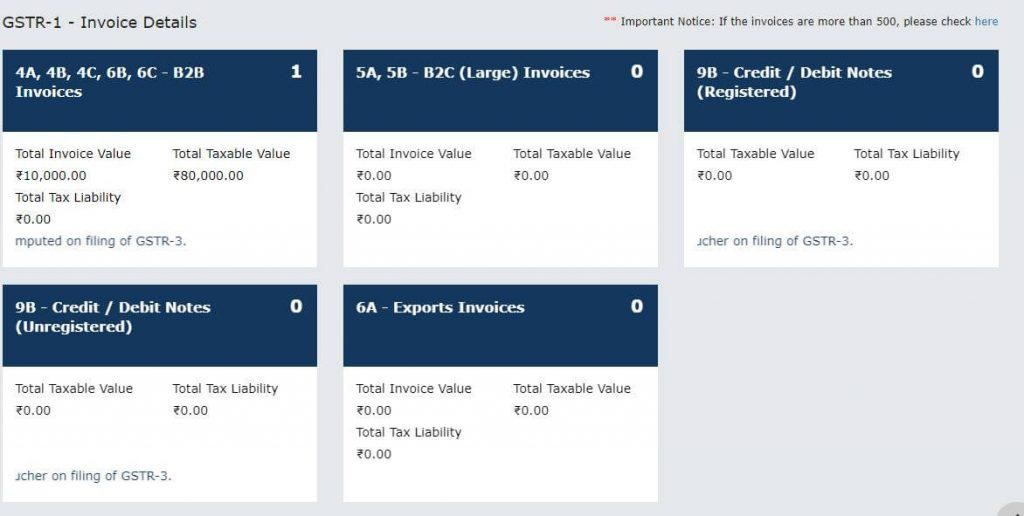The Goods and Service Tax puts forth several types of forms for taxpayers to file returns. These forms are classified based on the returns filing frequency and type of transaction undertaken.

Table of Contents
ToggleWhat is GSTR-1?
Who Should File GSTR 1?
GSTR 1 must be filed by every registered taxpayer. It has to be filed even if the taxpayer has had no transactions in a month.
Registered individuals who do not have to file this form include –
- Taxpayers liable to collect TDS.
- Those liable to collect TCS.
- Suppliers of Online Information Database Access and Retrieval (OIDAR) services (as per Section 14 of the IGST Act).
- Non-resident taxable persons.
- Taxpayers registered under the GST composition scheme.
- Input Service Distributors (ISDs).
Considerations While Filing GSTR – 1
- You need to be a registered taxpayer under GST, and also have a 15-digit PAN-based GSTIN.
- You need to have detailed invoices with their unique serial numbers.
- You also need an OTP to verify your registered mobile number with GST.
GSTR-1 due date
The due dates for GSTR-1 are based on your aggregate turnover.
Businesses with sales of up to Rs.5 crore have an option to file quarterly returns under the QRMP scheme and are due by the 13th of the month following the relevant quarter.
Whereas, those taxpayers who do not opt for the QRMP scheme or have a total turnover above Rs.5 crore must file the return every month on or before the 11th of the next month.
| For businesses with turnover | Month/Quarter | Due Date |
| More than Rs.5 crore | Jan 2024 | 11th Feb 2024 |
| Feb 2024 | 11th Mar 2024 | |
| Mar 2024 | 12th Apr 2024 (earlier 11th Apr 2024)* | |
| Apr 2024 | 11th May 2024 | |
| May 2024 | 11th Jun 2024 | |
| Jun 2024 | 11th Jul 2024 | |
| Jul 2024 | 11th Aug 2024 | |
| Aug 2024 | 11th Sept 2024 | |
| Sept 2024 | 11th Oct 2024 | |
| Oct 2024 | 11th Nov 2024 | |
| Nov 2024 | 11th Dec 2024 | |
| Dec 2024 | 11th Jan 2025 | |
| Jan 2025 | 11th Feb 2025 | |
| Feb 2025 | 11th Mar 2025 | |
| Mar 2025 | 11th Apr 2025 | |
| Turnover up to Rs.5 crore (QRMP Scheme) | Oct-Dec 2023 | 13th Jan 2024 |
| Jan-Mar 2024 | 13th Apr 2024 | |
| Apr-Jun 2024 | 13th Jul 2024 | |
| Jul-Sept 2024 | 13th Oct 2024 | |
| Oct-Dec 2024 | 13th Jan 2025 | |
| Jan-Mar 2025 | 13th Apr 2025 |
How Can Taxpayers File GSTR 1?
Step 1 – Visit the GST Portal and log in.
Step 2 – Click the “Services” tab.
Step 3 – Select “Returns” and then “Returns Dashboard”.
Step 4 – Select the relevant Financial Year and Return Filing Period from the drop-down menus.
Step 5 – Click “Search”.
Step 6 – Under the first search result – “Details of outward supplies of goods or services”, select “Prepare Online”. Select “Prepare Offline” if your number of invoices is more than 500.
Step 7 – Fill in the sections.
GSTR-1 late fees and penalty
| Name of the Act | Late fees for every day of delay | Maximum late fee (if the annual turnover in the previous financial year is up to Rs.1.5 crore) | Maximum late fee (If the annual turnover ranges between Rs.1.5 crore and Rs.5 crore) | Maximum late fee (If the turnover is more than Rs.5 crore) |
| CGST Act, 2017 | Rs 25 | Rs 1,000 | Rs 2,500 | Rs 5,000 |
| Respective SCGT Act, 2017 / UTGST Act, 2017 | Rs 25 | Rs 1,000 | Rs 2,500 | Rs 5,000 |
| Total late fees to be paid | Rs 50 | Rs 2,000 | Rs 5,000 | Rs 10,000 |
The following table explains the late fee to be charged in case of nil GSTR-1 filing:
| Name of the Act | Late fees for every day of delay | Maximum late fee |
| CGST Act, 2017 | Rs 10 | Rs 250 |
| Respective SCGT Act, 2017 / UTGST Act, 2017 | Rs 10 | Rs 250 |
| Total late fees to be paid | Rs 20 | Rs 500 |
FAQs
Can I file GSTR-1 after the due date?
Yes, you can file the GSTR-1 even after the due date. However, you have to pay a late fee based on the delayed number of days.
Can I change a bill/ invoice uploaded on the GST portal?
After uploading bills you can make changes multiple times. There is no restriction on changing invoices after uploading them. But you can change an invoice only before submitting a return. Once submitted, the numbers are frozen.